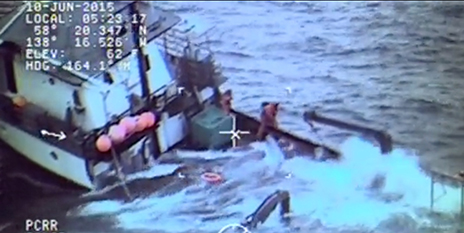I admit it. I don’t like heights and I don’t enjoy having to swim in cold water. That eliminates a lot of useful or exciting life choices: anything having to do with climbing rocks taller than I am, surfing in New England (Southern California or Tahiti would be great), flying in small airplanes and helicopters — especially helicopters. I couldn’t imagine being a Coast Guard rescue swimmer free-falling out a helicopter’s open door, into cold, cold Alaskan water to save the lives of hapless fishermen.
The crew of the tender Kupreanof abandon ship as it sinks off the coast of Alaska. Screen grab from Coast Guard video.Fortunately, some people thrive in that environment; otherwise a lot of fishermen wouldn’t be around today. Thus on Sept. 2, the Coast Guard Foundation, a non-profit organization committed to the education and welfare of all Coast Guard members and their families, recognized four members of a Coast Guard rescue team for their role in saving the crew of the tender Kupreanof. The rescue team was composed of Lt. Cmdr. Christopher Stoeckler, Lt. Benjamin Neal, AET2 Jamie Flood and AST2 Jason Yelvington.
On June 8, 2015, the Kupreanof was going from Petersburg, Alaska, to Bristol Bay, where the 73-footer would work as a tender, when the captain sent out a message at 3:45 a.m. saying the Kurpreanof was taking on water off Lituya Bay.
That’s when a Coast guard MH-60 Jayhawk helicopter was dispatched from Sitka on a 130-mile flight to find the Kupreanof in what was described as poor visibility, heavy wind, driving rain and 6-foot seas.
When the helicopter arrived, the Kupreanof was partially submerged with a life raft attached to the boat’s stern. The crew had gotten into survival suits. Assessing the situation from about 80 feet above the water, Stoeckler, the helicopter’s pilot, told them to abandon ship.
Then Yelvington, the rescue swimmer, dropped out of the helicopter and into the water and helped the crew climb into the life raft. However, it was deemed too risky to hoist the crew directly from the life raft up to the helicopter because the rotor wash might blow the raft back into the sinking boat.
Thus one-by-one, Yelvington took the crew from the raft to where they could get in the rescue basket and then be lifted to the helicopter. All the while, Yelvington’s job was made difficult by fumes from diesel fuel than covered the water.
As the last basket was being hoisted into the helicopter, the Kupreanof sank, taking the raft with it. Emergency medical personnel checked out the four crewmen and Yelvington; other than exposure to diesel fumes there weren’t any medical issues.







